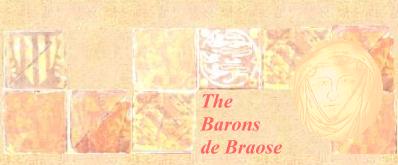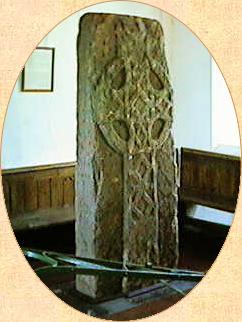
Churches
& Castles
 William
de Braose was as god fearing as his ancestors, despite his savage
reputation. Five years later he remembered the atrocity he committed
against the Welsh princes and sought atonement by massively extending
the church of Saint
Mary de Haura in
New Shoreham, Sussex. He later rebuilt or restored many
of the churches within his Welsh domains. These included Saint
Bridget's in Skenfrith, Saint Nicholas' in Grosmont, Saint John's
in Brecon and Saint Mary's in Abergavenny.
William
de Braose was as god fearing as his ancestors, despite his savage
reputation. Five years later he remembered the atrocity he committed
against the Welsh princes and sought atonement by massively extending
the church of Saint
Mary de Haura in
New Shoreham, Sussex. He later rebuilt or restored many
of the churches within his Welsh domains. These included Saint
Bridget's in Skenfrith, Saint Nicholas' in Grosmont, Saint John's
in Brecon and Saint Mary's in Abergavenny.
Gerald of Wales wrote a
famous account of his Welsh tour during 1188. He met William
de Braose in Brecon and described him as a pious man, riding
about the town on his horse exchanging God's blessings with little
children. Gerald also complimented William's wife Maud for her
efficiency as a housekeeper. In fact, as archdeacon of Brecon,
Gerald knew the family well.
Some
strange folk tales about Maud de Saint Valery have survived.
One story calls her Moll Walby and tells how she built the castle
of Hay on Wye, single handed in one night. She carried the stones
in her apron but one lodged itself in her slipper. She flicked
it out over the river Wye three miles away, where it survived
the centuries as a nine foot tall standing stone with magical powers.
 Substantial
remains of the de Braose castles can still be seen in the marches.
The towns of Abergavenny, Hay and Brecon were each dominated
by a massively fortified family residence. The armoured and mounted
knights which clattered over the drawbridges were a persistent
menace.
Substantial
remains of the de Braose castles can still be seen in the marches.
The towns of Abergavenny, Hay and Brecon were each dominated
by a massively fortified family residence. The armoured and mounted
knights which clattered over the drawbridges were a persistent
menace.
A typical piece of folk
lore begins two miles from Matilda's (or Pains) castle. The baron
was returning with his men from a hunting expedition when they
spotted a Welsh princess and her attendants bathing in a lake.
William carried off the women and imprisoned them in the castle.
The princess caught the attention of her grieving relatives by
holding a family token over a candle at her dark prison window.
William denied that he had taken the girl but Rhys ap Gruffydd
launched a bloody attack on the castle and rescued her.
The great lord Rhys of
Deheubarth did lead a massive campaign in 1196, taking Matilda's
castle, Builth, Radnor and others before his death in a terrible
plague the following year. Perhaps there is some truth in the
folk tale.

back
to text

back to text
 Churches & Castles |
||||
Gerald of Wales wrote a famous account of his Welsh tour during 1188. He met William de Braose in Brecon and described him as a pious man, riding about the town on his horse exchanging God's blessings with little children. Gerald also complimented William's wife Maud for her efficiency as a housekeeper. In fact, as archdeacon of Brecon, Gerald knew the family well. Some strange folk tales about Maud de Saint Valery have survived. One story calls her Moll Walby and tells how she built the castle of Hay on Wye, single handed in one night. She carried the stones in her apron but one lodged itself in her slipper. She flicked it out over the river Wye three miles away, where it survived the centuries as a nine foot tall standing stone with magical powers.
A typical piece of folk lore begins two miles from Matilda's (or Pains) castle. The baron was returning with his men from a hunting expedition when they spotted a Welsh princess and her attendants bathing in a lake. William carried off the women and imprisoned them in the castle. The princess caught the attention of her grieving relatives by holding a family token over a candle at her dark prison window. William denied that he had taken the girl but Rhys ap Gruffydd launched a bloody attack on the castle and rescued her. The great lord Rhys of
Deheubarth did lead a massive campaign in 1196, taking Matilda's
castle, Builth, Radnor and others before his death in a terrible
plague the following year. Perhaps there is some truth in the
folk tale.
|
||||